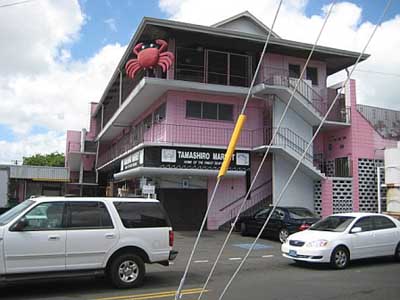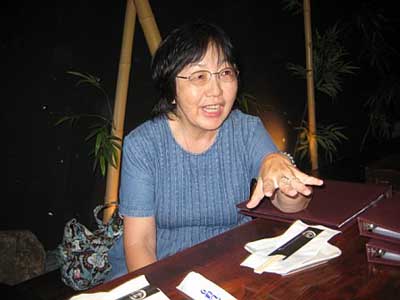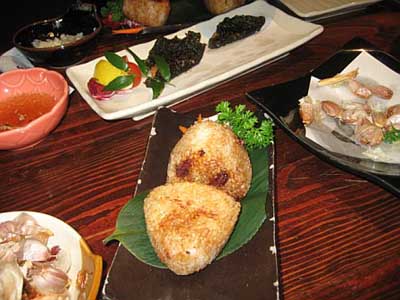 Tamashiro Market, a jam packed shop on a busy street corner. Bill took us there for corn flake cookies, which were, as promised, fantastic. Tamashiro Market, a jam packed shop on a busy street corner. Bill took us there for corn flake cookies, which were, as promised, fantastic. |
Thursday, Sept. 20
This was a food and friendship day. We got up and had a leisurely morning, hanging around Richela’s condo. Then Erin and I drove past downtown to meet up with Bill Rose, one of the more intriguing people I know.
So let me tell you about Bill Rose.
I first got to know Bill through a series of CDs he produced. The first was called “Club Nisei” and I bought it during a trip to San Francisco a few years ago. It caught my eye because of the archival photo on the cover, and the liner notes, written by the CD’s producer, Bill Rose. The CD was a compilation of music recorded by Nisei musicians in Hawaii during the 1940s and ’50s who were known as Club Nisei, and the liner notes chronicled the vibrant music scene of the band’s heyday. Rose came across the dusty original tapes in a studio, got permission to re-release the music. He discovered during his research that one of the original musicians lived in his neighborhood, and he was able to write a vivid description of the music scene that produced the tracks.
The songs range from Japanese folk music and children’s songs to pre-war Japanese pop, and brassy, post-war big band songs, all sung in Japanese. I wrote about it in my Nikkeiview column back in 2000, and also in 2001 about one of the followup CDs, “Paradise Honolulu.” You can read some other reviews on Amazon.com, which seems to be written mostly by former GIs who had been stationed in Japan or took R&R in Hawaii during the Occupation years and into the 1950s, who remembered the songs as being popular hits back in the day.
I loved the CD immediately, and soon discovered Rose was releasing more music from that era, ranging from more Club Nisei to a compilation by the Hawai’i Shochiku Orchestra, and later, a very cool “lounge” collection of Japanese American musicians playing Latin-tinged instrumental numbers, titled “Ultra Vibe: Exotic Hawai’i.”
I finally got so curious about Billy Rose that I tracked down an e-mail address for him in Hawaii and struck up a long-distance correspondence. When I attended the 2004 JACL National Convention in Honolulu, I made a point of getting touch and spending a day tooling around Oahu with him.
That day he took me to a bunch of touristy must-sees – Punch Bowl, the Pali Lookout – but also to some of his favorite local haunts – a lunch joint that defined “greasy spoon” with a Hawaiian cuisine twist, a shave ice hole-in-the-wall (since closed, sadly), where a Chinese woman baked up bags and bags of amazingly delicious corn flake shortbread butter cookies, and Ray’s Café, another Hawaiian tradition for plate lunches, not unlike Helena’s).
 We laughed unbelievably hard with Bill Rose in just the few hours we spent with him. |
Billy himself turned out to be a world-class raconteur and a mysterious one at that, who talks with the energy and urgency of a New Yawker (not a laid-back islander), and lives life at an intense pace. I never quite figured out what he does for a living, except that he’s worked in finance and once had an office in the World Trade Center, but that he returned to Hawaii, where he was born and raised, and does what he likes and stays “off the grid,” as he says. (It’s true: Google his name and you won’t find much beyond some references to his role as producer for “Club Nisei.”)
For this trip, we had arranged to meet up, and both regretted that we didn’t have more time to spend. Bill’s a fascinating guy, who is very Japanese (his mother was Japanese, and his father Caucasian. He’s a third-generation, or sansei, hapa (half Japanese). And he knows Hawaii inside out, loves research, factoids, music, trivia, politics, culture, food – he’s a lot like me.
Erin and I arranged to meet him in the parking lot of Marukai, the Japanese market between downtown and the airport. We were supposed to shop there first, then go to lunch with Bill, then head back to Richela’s. But we got a late start and just drove to the Marukai parking lot and ended up never even shopping there. Because the parking lot was so jammed, Bill had us follow him to a residential area where we walked a block to Matsumoto’s Okazuya and Japanese Restaurant for lunch.
“Okazu” is part and parcel of Japanese home-cooking. It’s what you make with leftovers and reflects the cultural value of not wasting anything, as well as the warmth of family-style cooking. So at the counter when you walk in the door of the tiny, funky spot, you can order some of the day’s okazu – stews and fried chicken and spam musubi – to go. Father in there are a handful of tables and booths where people can sit down for a meal. The menu is standard Japanese fare with a dose of Hawaiian attitufe thrown in. Bill introduced us to the owner, Todd Matsumoto.
Bill’s a fan of the place because Todd has been true to his roots. He grew up in the neighborhood, and eventually returned to open his restaurant, and hires local young people to help run the place. The food’s very much Japanese home cooking, with the ubiquitous Hawaiian plate lunches available to go. The food’s also super-affordable – no highbrow stuff here!
After our meal, Bill drove us around in his generic brown late-model Malibu. Ever the fount of historic details about his beloved Hawaii, he drove us into the compound of a Buddhist temple, explaining that it used to serve the workers for a sugar plantation, and pointing to a smokestack across the highway. That’s where the sugar processing plant used to be, he told us while he drove us around like a crazed New York cabbie.
The next day, as we walked through the Japanese Cultural Center’s permanent exhibit of the history of Japanese in Hawaii, we saw an archival photo of the very same sugar plantation with its immediately identifiable smokestack, and in the foreground, the original version of the Buddhist temple. It was cool to fell like we’d previewed a bit of history, as it were….
Before Bill took us back to our car by Matsumoto’s Okazuya, he had a couple more stops. First, he took us a couple of minutes away from Aloha Stadium to an industrial part of town to a warehouse with a small shop in front. The sign said “Ani’s Bake Shop,” and the building is the bakery, which supplies breads and pastries to retailers and restaurants.
He left us waiting in the car while he went in for our surprise present, which turned out to be Ani’s famous sweet potato pie, with a butter macadamia crust and topped with a layer of creamy haupia, the coconut custard. Bill had to order it at least 24 hours in advance. The Okinawan sweet potato is a deep purple delicacy that’s not too sweet; the pie was a dream delight, and we had to work hard at finishing it off between us and Richela (we gave a couple of pieces to cousin Aileen too).
On the way back to our car we made a passing remark about looking for corn flake cookies and he drove us to Tamashiro Market, a jam-packed seafood, grocery and deli. We bought some bags of cookies, and also a tub of fresh poke and a purplish-brown taro cake square to try later at Richela’s.
We bid farewell to Bill, and he offered to help do research on my family history. We’d laughed unbelievably hard in the few hours we’d spent with him damn, he’s funny!), and I know we’ll be in touch with him, and see him again.
 Cousin Aileen handled the ordering at the izakaya, Momomo. Cousin Aileen handled the ordering at the izakaya, Momomo. |
On the way back to Richela’s, we stopped at a Barnes & Noble to see if there were local authors we could pick up (Erin recalls how she found a treasure trove of Hawaiian literature on one trip to Hawaii) but we didn’t see any books that called out to us this time.
Once back at Richela’s we planned our next meal. Can you start to see our pattern? We live for food, and from meal to meal.
The meal for tonight was a different take on Japanese, thanks to Aileen. Although she’d been working all day, she offered to take us, generously including Richela, to a downtown izakaya called Momomo. An izakaya can be best described as a Japanese tapas bar, or Japanese dim sum – in Japan, they’re where businessmen can go to drink after work and take the edge off their hunger with small plates of individual orders off a large menu of items.
Everything was different from the izakaya fare we’d had recently in Boulder at a terrific tiny restaurant called Amu. These dishes were all unique and creative and beautiful and of course, fabulous.
 Momomo served simple but elegant food: grilled rice balls, fried garlic, tempura shrimp and triangles of mountain yam (a Japanese delicacy) wrapped in seasonsed seaweed. Momomo served simple but elegant food: grilled rice balls, fried garlic, tempura shrimp and triangles of mountain yam (a Japanese delicacy) wrapped in seasonsed seaweed. |
We let Aileen, who knew the place, order most of the food, and it turned out to be a delight, with table-made tofu (yummy and silky), grilled rice ball, yamaimo (mountain yam) inside Korean nori, or seaweed, tonkatsu (breaded pork cutlet) on a skewer, a killer eggplant beef dish, heavenly deep-fried garlic and a lot more.
While we ate late into the night, a nice jazz soundtrack played over the restaurant’s sound system. The place wasn’t crowded, which surprised Aileen, so we had a lot of privacy to talk and laugh and enjoy the food.
It was good to talk further about our family history, and to share conversation over such tasty and unique vittles.










